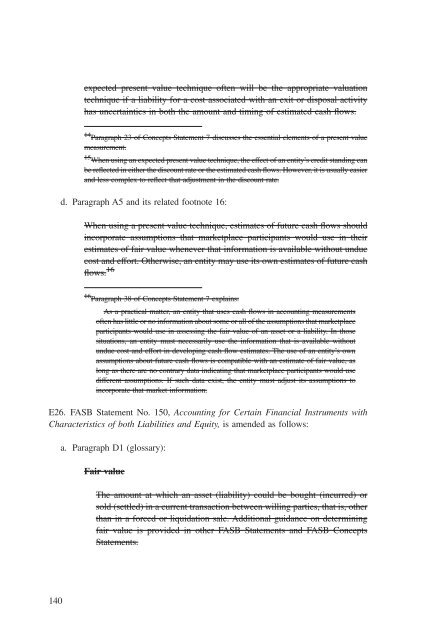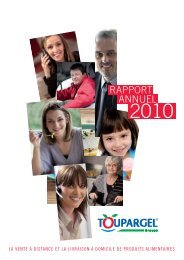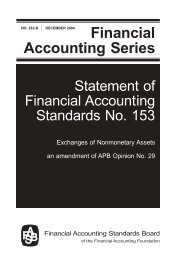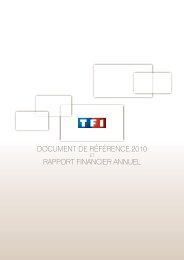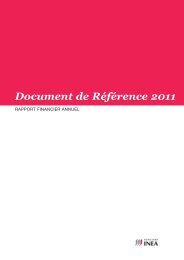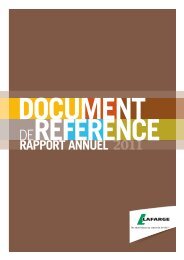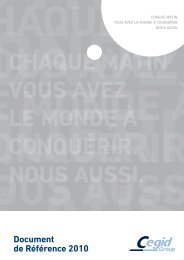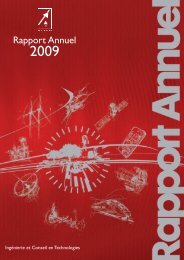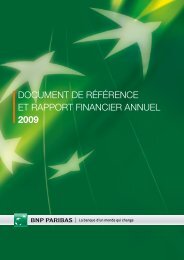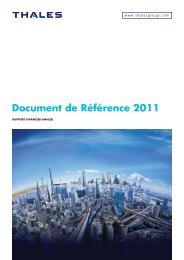Statement of Financial Accounting Standards No. 157 - Paper Audit ...
Statement of Financial Accounting Standards No. 157 - Paper Audit ...
Statement of Financial Accounting Standards No. 157 - Paper Audit ...
Create successful ePaper yourself
Turn your PDF publications into a flip-book with our unique Google optimized e-Paper software.
expected present value technique <strong>of</strong>ten will be the appropriate valuation<br />
technique if a liability for a cost associated with an exit or disposal activity<br />
has uncertainties in both the amount and timing <strong>of</strong> estimated cash flows.<br />
14 Paragraph 23 <strong>of</strong> Concepts <strong>Statement</strong> 7 discusses the essential elements <strong>of</strong> a present value<br />
measurement.<br />
15 When using an expected present value technique, the effect <strong>of</strong> an entity’s credit standing can<br />
be reflected in either the discount rate or the estimated cash flows. However, it is usually easier<br />
and less complex to reflect that adjustment in the discount rate.<br />
d. Paragraph A5 and its related footnote 16:<br />
When using a present value technique, estimates <strong>of</strong> future cash flows should<br />
incorporate assumptions that marketplace participants would use in their<br />
estimates <strong>of</strong> fair value whenever that information is available without undue<br />
cost and effort. Otherwise, an entity may use its own estimates <strong>of</strong> future cash<br />
flows. 16<br />
16 Paragraph 38 <strong>of</strong> Concepts <strong>Statement</strong> 7 explains:<br />
As a practical matter, an entity that uses cash flows in accounting measurements<br />
<strong>of</strong>ten has little or no information about some or all <strong>of</strong> the assumptions that marketplace<br />
participants would use in assessing the fair value <strong>of</strong> an asset or a liability. In those<br />
situations, an entity must necessarily use the information that is available without<br />
undue cost and effort in developing cash flow estimates. The use <strong>of</strong> an entity’s own<br />
assumptions about future cash flows is compatible with an estimate <strong>of</strong> fair value, as<br />
long as there are no contrary data indicating that marketplace participants would use<br />
different assumptions. If such data exist, the entity must adjust its assumptions to<br />
incorporate that market information.<br />
E26. FASB <strong>Statement</strong> <strong>No</strong>. 150, <strong>Accounting</strong> for Certain <strong>Financial</strong> Instruments with<br />
Characteristics <strong>of</strong> both Liabilities and Equity, is amended as follows:<br />
a. Paragraph D1 (glossary):<br />
Fair value<br />
The amount at which an asset (liability) could be bought (incurred) or<br />
sold (settled) in a current transaction between willing parties, that is, other<br />
than in a forced or liquidation sale. Additional guidance on determining<br />
fair value is provided in other FASB <strong>Statement</strong>s and FASB Concepts<br />
<strong>Statement</strong>s.<br />
140


